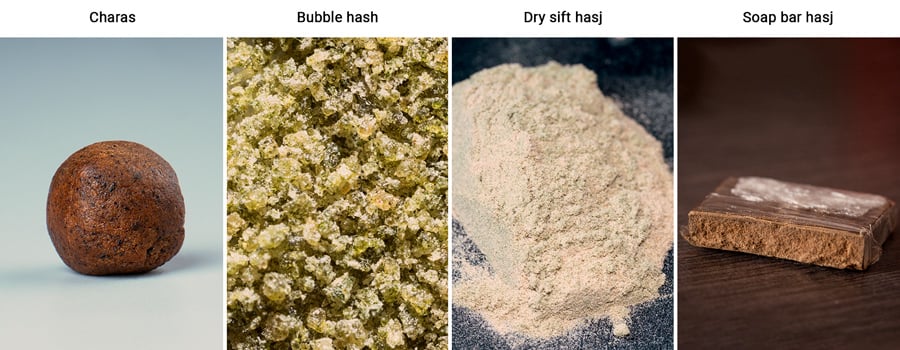In the realm of cannabis enthusiasts, hashish holds a revered status. This extract, rich in flavorful terpenes and potent THC, boasts a storied history dating back centuries. Yet, not all hashish is created equal. Some may harbor fillers that pose potential health risks. It’s imperative to discern high-quality hashish from inferior or hazardous substances.
Exploring Hashish Varieties
Before delving into the intricacies of distinguishing good from bad hashish, let’s survey the diverse array of hashish products available at dispensaries, coffee shops, or from local enterprising hobbyists. Key types of hashish include:

Charas
Charas, with origins tracing back thousands of years to the Indian subcontinent, involves the hand-rolling of resin collected from live cannabis buds. This method yields balls bursting with flavor, boasting a distinctive stickiness and freshness.
Bubble Hash
Also known as water hash, bubble hash represents a popular contemporary approach to obtaining concentrated trichomes. Manufacturers utilize an ice water bath to liberate resin glands from plant material, subsequently filtering and drying this cool mixture to yield a pure and flavorful end product.
Dry Sift Hash
Characterized by shaking dried buds over a fine-mesh sieve, dry sift hash collects liberated trichomes in a receptacle. These trichomes are then compressed into a compact block or disc. Some aficionados refer to non-pressed dry sift hash as kief.
Soap Bar Hash
Originating from Morocco, soap bar hash earned a notorious reputation in Europe during the 1990s. Transported in 250-gram bars, this product often contained fillers to increase weight and profits. Fortunately, encounters with soap bar hash are now rare.
Identifying High-Quality Hashish
Now equipped with knowledge of prevalent hashish types, let’s delve into the indicators of superior quality hashish. While many variables influencing hashish quality may not be quantifiable for the average consumer, attention to specific qualities can enhance the likelihood of purchasing a premium product:
Color
Hashish coloration can vary widely, ranging from light blond to deep amber, depending on trichome ripeness. Acceptable hues span light to dark browns. However, excessively dark or clumpy hashish may indicate plant material and chlorophyll contamination.

Texture and Consistency
High-quality hashish should exhibit neither liquid consistency nor excessive moisture. It should possess a pliable texture, sticky yet easy to manipulate—capable of forming balls or strands, yet crumbleable for joint or blunt application.
Trichome Density
Assessing trichome density may prove challenging for novice hashish enthusiasts. Pure hashish comprises a homogenous mass predominantly consisting of ruptured trichomes. The presence of impurities diminishes trichome density, though precise ratios remain elusive without technical analysis equipment.
Purity
Distinctive flavors, textures, and colors characterize various high-quality hashish types, underscoring the importance of purity. Rigorous testing, available at reputable dispensaries, provides insights into heavy metal, pesticide, and mycotoxin content—information often unavailable from local dealers or unofficial sources.
Aroma and Taste
Quality hashish exudes a plethora of aromas and flavors, ranging from pine and fruit to citrus and earth, owing to the presence of aromatic molecules within trichomes. Conversely, inferior hashish may emit a grassy odor devoid of complexity.
Burning Characteristics
After thorough inspection, it’s time for the ultimate test—ignition. High-quality hashish, when lit, assumes a dark gray hue, emitting a pleasant aroma and occasionally bubbling as oils vaporize. Conversely, inferior hashish smolders, burns black, and may emit unpleasant odors.
Conducting the Bubble Test
For those dealing specifically with bubble hash, the bubble test serves as a reliable gauge of quality. Follow these steps to assess your bubble hash:
- Retrieve a small piece of bubble hash.
- Place it in a heat-resistant container, such as a pipe or bong bowl.
- Apply heat to the container’s exterior to warm the hash piece via conduction.
- Observe the hash’s reaction to heat, ideally manifesting vigorous bubbling indicative of resin content.
Embarking on Your Journey to Hashish Connoisseurship
Feel that? It’s the sensation of enlightenment as your understanding of hashish deepens. While you may not yet rival renowned experts like Frenchy Cannoli, you now possess the knowledge to distinguish good from bad hashish. This not only enhances your ability to procure the finest hashish in your vicinity but also safeguards against consuming low-quality products potentially laden with harmful additives.
Disclaimer:
This content serves solely for educational purposes. Information provided originates from research compiled from external sources.
Seeking the finest edibles in Amsterdam? Let’s discover where you can find the tastiest treats!